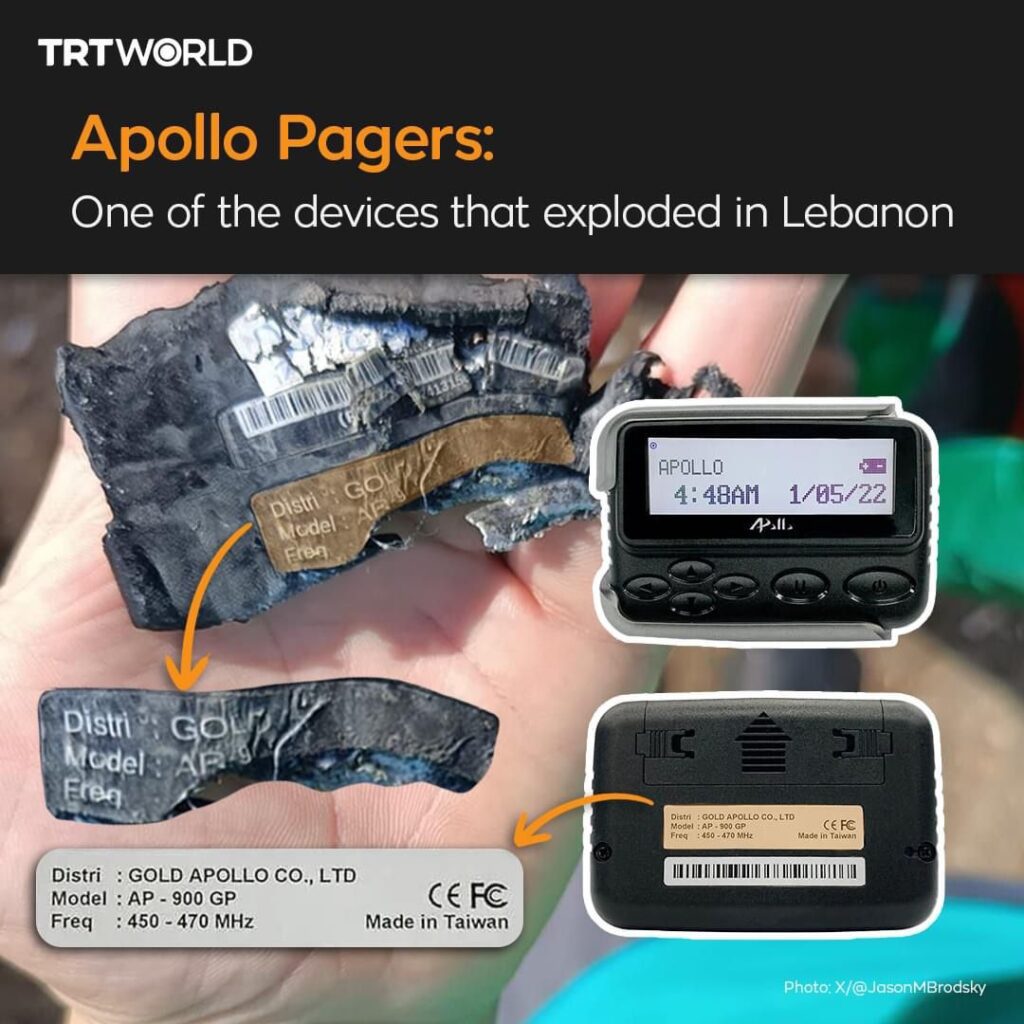Subtotal $0.00
POSSIBLE SCENARIOS
If pager devices explode simultaneously across a state, it suggests a highly coordinated and sophisticated attack. Several other potential attack vectors beyond the possibilities are there such an event. Let’s explore the most plausible attack vectors in this context:
- Pre-Planted Explosives with Remote Detonation (Likely)
Description: This is one of the simplest and most effective methods, where small explosive devices are planted inside the pagers before they are distributed. These explosives could then be remotely detonated using RF signals or other communication methods.
Feasibility: Given the precision required for simultaneous explosions, this would likely involve a sophisticated actor, possibly a state or well-funded militant group, that can access the devices beforehand.
Coordination Method: The explosives would be triggered by sending a specific RF signal or command that synchronizes the detonation. - Supply Chain Compromise (Likely)
Description: A supply chain attack could involve compromising the hardware or firmware of the pagers during manufacturing or distribution. Malicious components, such as micro-detonators or firmware instructions to trigger battery malfunctions, could be embedded during the production phase.
Feasibility: This would require control over the manufacturing or distribution processes, either by hacking into the system that produces these devices or by coercing personnel involved in the manufacturing.
Coordination Method: Malicious code or hardware could be programmed to activate under specific conditions, such as receiving a particular signal, GPS location, or date and time. - Firmware or Software Exploit (Plausible)
Description: If the pagers have any form of remote firmware update capability or over-the-air communication protocols, they could be exploited through a vulnerability in the firmware. Attackers could push malicious code that directly manipulates the power management or battery systems, potentially leading to overheating and explosions.
Feasibility: This depends on whether the pagers allow for remote updates or communication beyond basic paging signals. It would also require a sophisticated exploit to control the battery or internal components.
Coordination Method: A firmware update could be timed or triggered by a specific external signal, like a command from a central server or satellite. - Electromagnetic Pulse (EMP) Attack (Plausible)
Description: An electromagnetic pulse (EMP) can disrupt or destroy electronic devices within a certain radius. A localized EMP attack could be deployed in specific areas, causing mass device failure or explosions if the batteries inside the pagers are susceptible to thermal runaway due to electrical overload.
Feasibility: This is possible if attackers have access to EMP devices, but the infrastructure and precision required to execute a simultaneous, state-wide EMP attack would be substantial.
Coordination Method: A highly specialized EMP device could be activated at multiple locations to coincide with a synchronized event, possibly using drones or ground-based systems. - Radio Frequency (RF) Hacking or Signal Injection (Possible)
Description: RF signal jamming or signal injection could target the frequencies used by pagers. If the attackers can manipulate or overload these signals, it might cause internal circuit failure, leading to overheating. In theory, a highly focused RF attack could overload the pager’s power management systems, potentially causing damage to the lithium-ion batteries.
Feasibility: This would require detailed knowledge of the pager’s communication protocols, frequency bands, and circuitry. The likelihood of causing a simultaneous explosion through signal overload alone is relatively low, but it’s a potential vector if combined with other vulnerabilities.
Coordination Method: RF transmitters strategically placed across the state could synchronize an attack, transmitting high-energy signals on the specific frequencies used by the pagers. - Backdoor or Hardware Trojan in the Device (Possible)
Description: If the pagers were compromised during manufacturing, either through malicious firmware or hardware backdoors (e.g., a hardware trojan), attackers could trigger this code remotely. Hardware trojans can lay dormant until activated by a specific signal or environmental condition (like a particular temperature or GPS location).
Feasibility: This would require substantial technical sophistication and access to the hardware design of the pagers. The backdoor could be placed during design, manufacture, or distribution.
Coordination Method: The trojan could be activated remotely using RF signals, GPS triggers, or even a certain signal received by the pagers.
| S. No | Vulnerable Models : | Frequency Used : | Distributor: |
| 1 | AR-924 | 450 – 470 MHz | Gold Apollo Co Ltd |
| 2 | AP – 900 GP | 450 – 470 MHz | Motorola |

The Danger of Technology: Lithium Batteries and Their Role in Cyber Warfare*
Lithium Batteries: Silent Threats in Cyber Warfare
Lithium-ion batteries, which power many modern devices, are often seen as benign, everyday objects. However, their chemical structure makes them vulnerable under specific conditions. These batteries store energy in the form of highly reactive lithium compounds. If exposed to a high level of heat, physical damage, or—more disturbingly—a well-placed signal, they can combust or even explode. Such batteries are often prohibited to carry while traveling from Air plane / Railway. This phenomenon has been exploited in military and espionage contexts, where technological devices powered by lithium batteries can be remotely detonated, turning ordinary communication tools into deadly weapons.
In the case of the Hezbollah pager explosions, the situation exemplifies how easy it is to manipulate everyday technology for lethal purposes. The group had shifted to using pagers instead of mobile phones, likely to evade tracking by advanced Israeli intelligence systems. However, this strategy backfired when the pagers, powered by lithium batteries, were allegedly targeted by a remote signal.
How Strong Signals Trigger Lithium Battery Explosions
Lithium batteries are highly sensitive to external electromagnetic fields, including radio waves and other signals transmitted by communication towers. While under normal circumstances, these signals help power the devices by providing data or enabling communication, there is a darker side to this interaction.
A signal strong enough or sufficiently tuned can interfere with the electronic components that regulate the battery’s function. When this regulation is disrupted, the energy stored in the battery may be released all at once, causing the battery to overheat and explode. This type of attack is known as an “RF-induced failure,” where radio frequency signals cause devices to malfunction catastrophically.
In environments where conflict is prevalent, like the Israeli-Hezbollah border region, sophisticated attackers can weaponize such signals to sabotage devices used by adversaries. With modern military intelligence possessing the capability to pinpoint specific frequencies or vulnerabilities in devices, this type of attack becomes both feasible and highly destructive.
The Broader Implications of Technological Vulnerabilities
The incident involving Hezbollah’s pagers highlights the broad risks posed by everyday technologies when they fall into the hands of adversaries in a cyberwarfare context. What once seemed like an innocuous communication device became the target of a lethal operation.
This situation is a reminder of the evolving landscape of warfare, where attacks are not only physical but also digital. The use of cyber tactics, such as triggering lithium battery explosions remotely, signifies the new age of conflict where the line between technology and weaponry is increasingly blurred. The result is a world where everything from smartphones to medical devices can be manipulated or weaponized through cyber means.
Preventing Future Attacks
As the reliance on lithium batteries grows, so does the need for robust defenses against their potential exploitation. Device manufacturers must focus on creating safeguards within batteries to prevent RF-induced failures or similar forms of remote interference. At the same time, users, particularly those in high-risk environments like conflict zones, need to stay vigilant about the devices they use and how they interact with surrounding technologies.
RECENT THREAT OBSERVED
GoaChronicle through its intelligence network has learned that Israeli intelligence successfully intercepted a shipment of pager batteries that had been ordered from B&H Photo. The order was placed from Lebanon. Acting on a confirmed tip, the intelligence agency seized the shipment and covertly modified the batteries. Small, undetectable explosives known as Kiska 3 were inserted into the battery casings and connected to the battery wires via a discreet chip. The pager model was Rugged Pager AR924 IP67. The operation code word was ‘Below the Belt’.


Comments are closed